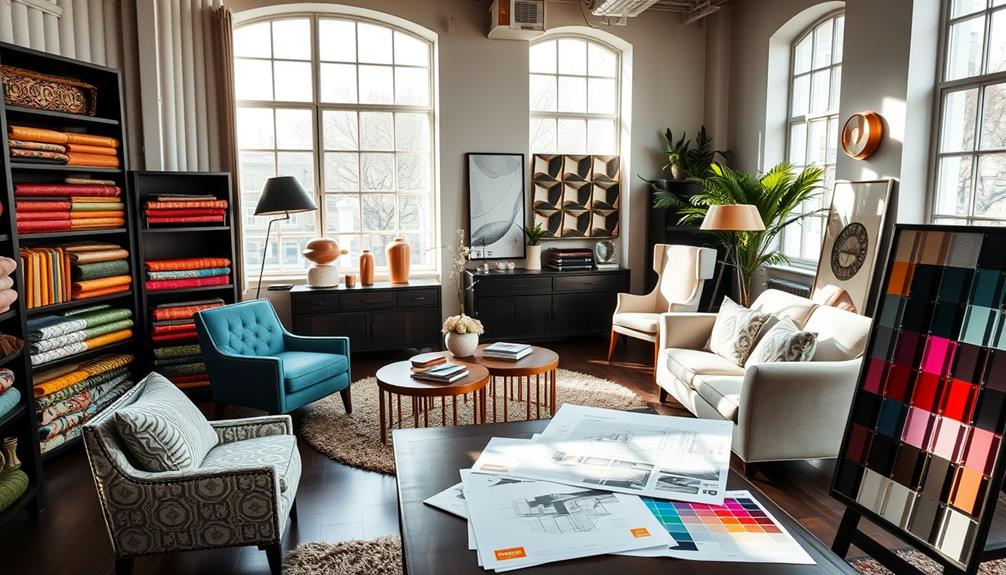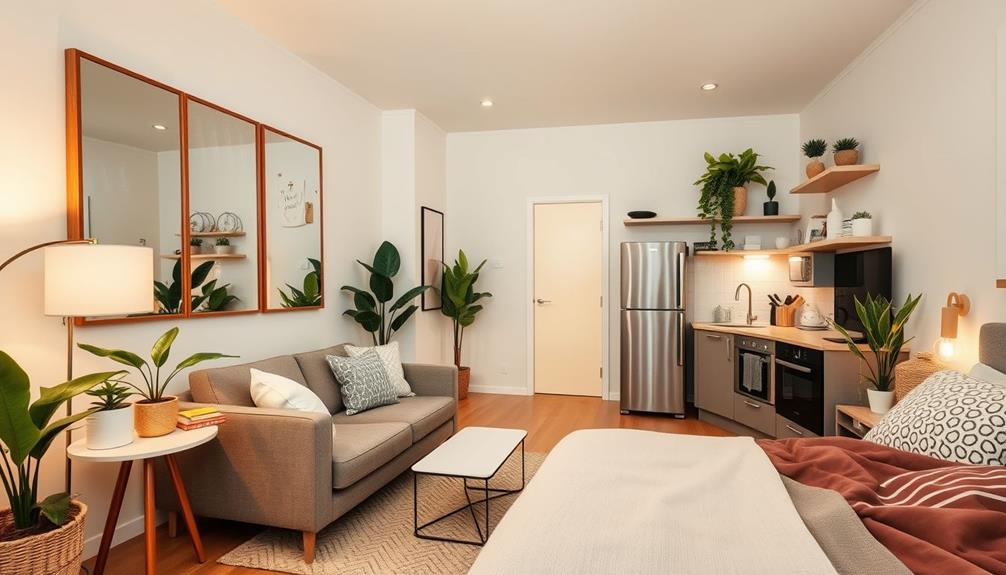To start your freelance interior design business, clearly define your services, like design consultations and e-design options. Build a strong portfolio showcasing your best work and guarantee it reflects diverse styles. Create a solid business plan outlining your goals and target audience. Register your business and establish an online presence with a professional website. Optimize your site for search engines to enhance visibility. Use social media to promote your services and connect with potential clients. Finally, network with industry professionals for collaboration opportunities. There's so much more to explore in building a successful brand and attracting clients effectively. Seek out mentorship and guidance from experienced interior design professionals to gain valuable insights and advice. Stay updated on current design trends and industry news to remain competitive and offer the latest innovations to your clients. Additionally, consider joining professional interior design associations and attending industry events to expand your network and stay connected with the latest in interior design freelancing tips.
Key Takeaways
- Define your services clearly, including design consultations, e-design, and project management, with transparent pricing structures.
- Build a diverse portfolio showcasing your best work, including before-and-after photos and various design styles.
- Create a comprehensive business plan outlining your mission, target market, financial projections, and marketing strategies.
- Establish a strong online presence with a professional website and optimized content to attract potential clients.
- Network with industry professionals, join associations, and attend events to build connections and collaborate on projects.
Define Your Services
Defining your services is the cornerstone of launching a successful freelance interior design business. Start by identifying specific offerings, like design consultations, space planning, and project management, to cater to varying client needs.
Consider differentiating your services into full-service design and e-design options. This gives clients the flexibility to choose hands-on collaboration or virtual consultations, depending on their preferences.
Next, create clear service descriptions that highlight your unique selling points. If you specialize in eco-friendly design or a particular style, make sure potential clients know it.
Outline your deliverables for each service, such as mood boards, 3D renderings, and personalized shopping lists, so clients understand what to expect.
Lastly, establish transparent pricing structures with tiered packages. This approach accommodates different budgets while ensuring clarity and avoiding confusion for potential clients.
Build Your Portfolio

To build a compelling portfolio, start by showcasing your design renderings, whether they're in 2D or 3D formats.
Capturing before-and-after photos of your projects will clearly demonstrate your ability to transform spaces.
Together, these elements will highlight your skills and attract potential clients.
Showcase Design Renderings
Showcasing your design renderings is essential for building a compelling portfolio that attracts clients and demonstrates your unique style. High-quality 2D and 3D design renderings visually represent your concepts, making it easier for clients to grasp your vision and facilitating their decision-making process.
By using software tools like SketchUp, AutoCAD, or Revit, you can create professional-grade renderings that highlight your technical skills and attention to detail. Additionally, understanding emotional attachment in pets can inspire creativity in your designs, as it reflects the importance of creating spaces that resonate with the people who inhabit them.
To truly stand out in the competitive interior design business, include a diverse range of design styles and color palettes in your renderings. This approach appeals to various client preferences and showcases your versatility as a designer. Regularly update your portfolio with new renderings from completed projects, ensuring it remains current and relevant while reflecting your evolving expertise.
While capturing before-and-after images can enhance your portfolio's persuasive power, focusing on the quality and diversity of your design renderings is vital. These renderings illustrate the transformative impact of your work, giving potential clients a clear picture of what they can expect when working with you.
Make sure your portfolio not only impresses but tells a story of your design journey.
Capture Before-and-After Photos
Capturing high-quality before-and-after photos is a powerful way to visually demonstrate the transformative impact of your design work.
These images not only showcase your skills but also attract potential clients who are enthusiastic to see real results.
Here's how to make them impactful:
- Consistent Lighting: Use the same lighting for both shots to create a cohesive visual narrative that highlights your design improvements.
- Angles Matter: Shoot from the same angle in each photo to emphasize the changes you've made.
- Tell a Story: Include a brief description of the design challenges faced and the solutions you implemented to provide context.
- Keep it Fresh: Regularly update your portfolio with new before-and-after photos to reflect your evolving design style and capabilities.
Don't underestimate the power of social media either!
Sharing these before-and-after photos can greatly increase your engagement and visibility, leading to more client inquiries.
With every transformation you document, you're building a compelling portfolio that not only showcases your talent but also resonates with those looking for their own design improvements.
Create a Business Plan

Creating a solid business plan is vital for launching your freelance interior design business. Start by detailing your mission and vision, which will guide your goals and decision-making.
Next, identify your target market demographics to tailor your services effectively. A competitive analysis is significant; by examining the strengths and weaknesses of existing businesses in your area, you can define your unique selling points and differentiate yourself.
Your financial plan should project sales, capital requirements, and cash flow statements for at least three years to guarantee your business is profitable and sustainable. This plan will help you understand your financial landscape and prepare for any challenges ahead.
Additionally, outline your marketing strategies, including digital marketing, networking, and promotional tactics, to effectively engage your target clients.
Determine the most suitable business structure, like a sole proprietorship or LLC, that aligns with your goals while considering the legal and tax implications of running your freelance interior design business.
A well-thought-out business plan not only sets the foundation for your company but also instills confidence in potential clients and partners. So, take the time to craft a thorough plan that reflects your vision.
Register Your Business

Registering your business is an essential step in establishing your freelance interior design career. This process not only legitimizes your venture but also opens up opportunities for growth and success.
Here are four important tasks you should tackle:
- Choose a unique business name that reflects your design style. Make certain to check its availability on your state's secretary of state website to avoid any conflicts.
- Select a suitable business structure—consider a sole proprietorship or LLC. It's wise to consult a business attorney to understand the legal implications and formalities involved.
- Obtain an Employer Identification Number (EIN) from the IRS. This number is vital for tax filing and opening a business bank account.
- Research and acquire necessary business licenses and permits specific to your state, especially since 24 states require licensure for interior designers.
Lastly, maintain organized documentation of all registrations, licenses, and permits. This guarantees compliance and helps you navigate audits or inspections smoothly.
Taking these steps lays a solid foundation for your freelance interior design business!
Establish Your Online Presence

To attract clients in the competitive interior design market, you need a strong online presence.
Start by building a professional website that showcases your portfolio and is optimized for search engines.
Then, leverage social media platforms to share your work and connect with potential clients.
Build a Professional Website
Building a professional website is essential for establishing your online presence as a freelance interior designer.
It's your digital storefront, and it needs to impress potential clients.
Here's how to create an effective site:
- Choose a Domain Name – Pick a name that reflects your brand and resonates with your audience.
- Select a User-Friendly Platform – Utilize platforms like WordPress or Squarespace to create an engaging and easy-to-navigate website.
- Showcase Your Portfolio – Include high-quality images of your design projects and client testimonials to build credibility and attract attention.
- Provide Clear Contact Information – Make sure your website features a professional email address and easy-to-find contact details for seamless communication.
Optimize for Search Engines
Optimizing your website for search engines is essential if you want to attract potential clients to your freelance interior design business. Start by registering a domain name that reflects your brand and securing reliable web hosting. This guarantees your website is professional and accessible.
Additionally, consider implementing keyword clustering to group related keywords, which can enhance your SEO and improve content discoverability.
Utilize platforms like WordPress or Squarespace to create a visually appealing website. Make certain to incorporate relevant keywords and metadata to enhance your search engine optimization (SEO) strategies. High-quality images of your design projects and client testimonials can greatly boost your credibility and help you stand out.
Implement content marketing by creating blog posts focused on design tips, trends, and case studies. This won't only improve your website's visibility in search results but also position you as an industry expert. Regularly updating your content keeps your audience engaged and encourages them to return.
Lastly, while you'll leverage social media platforms to showcase your portfolio and engage with potential clients, it's important to guarantee that your website remains the central hub for your interior design business. Drive traffic from your social media back to your site for maximum impact.
Utilize Social Media Marketing
While establishing your online presence, leveraging social media marketing can significantly enhance your freelance interior design business. By showcasing your design portfolio on platforms like Instagram and Pinterest, you tap into a vast audience enthusiastic to discover new styles.
Additionally, engaging with trends like unique water-based activities can inspire creative design ideas that resonate with potential clients. Here's how to maximize your impact:
- Post high-quality images of your projects and mood boards regularly; visuals attract 94% more views than text.
- Utilize relevant hashtags to boost visibility; posts with hashtags see a 12.6% increase in engagement.
- Engage with your audience by responding to comments and messages promptly, which can lead to a 20-40% increase in customer loyalty.
- Collaborate with influencers in the interior design industry to broaden your reach, as 49% of consumers trust their recommendations.
Promote Your Services

Promoting your services effectively is essential for attracting clients in the competitive world of freelance interior design. Start by developing a solid marketing plan that leverages social media platforms like Instagram and Pinterest. These platforms allow you to showcase your design projects visually, which can greatly increase engagement and attract potential clients.
Additionally, consider exploring the tiny house movement as a niche market, as it emphasizes minimalist living and sustainable design solutions that can appeal to eco-conscious clients.
Next, enhance your visibility by implementing search engine optimization (SEO) strategies on your website. This will improve your search rankings, making it easier for clients to find your services online.
Additionally, consider offering free or discounted initial consultations. This not only entices clients but also gives you a chance to demonstrate your expertise, leading to increased referrals and repeat business.
Don't forget to collect and showcase client testimonials on your website and in your marketing materials. Positive reviews can build credibility and trust with prospective clients, greatly influencing their purchasing decisions.
Network and Collaborate

Networking and collaborating are key strategies that can elevate your freelance interior design business. By building connections and forming partnerships, you can access new opportunities for client acquisition and growth.
Here are some effective ways to network and collaborate:
- Attend Design Events: Engage in local workshops and trade shows to meet potential clients and industry professionals. These events enhance your visibility and create lasting relationships.
- Join Professional Associations: Organizations like ASID or IIDA offer valuable resources, networking events, and industry insights that can help you stay ahead in the field.
- Utilize Social Media: Leverage platforms to connect with design communities, share your work, and engage with peers. This can foster a supportive network that encourages collaboration and knowledge sharing.
- Forge Creative Partnerships: Collaborate with photographers, artists, and other creatives to enrich your project offerings. Cross-promoting services through shared platforms expands your marketing reach.
Conclusion
Now that you've laid the groundwork for your freelance interior design business, the real adventure begins. Imagine transforming spaces and making clients' dreams come true, all while building your brand. But are you ready to face the challenges that lie ahead? The competition is fierce, and every decision counts. As you plunge into this vibrant world, remember: success isn't just about creativity; it's about resilience and strategy. What will your next step be? The future's waiting!









